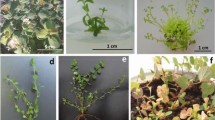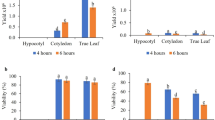Abstract
Strong allelopathic activities of etiolated seedlings of a leguminous plant, Vicia villosa Roth (hairy vetch), were confirmed by a protoplast co-culture method. The combination of 1% Cellulase RS and 1% Driselase 20 in 0.4 M mannitol solution was used for protoplast isolation. The inhibitory effects of V. villosa protoplasts on the growth of recipient Lactuca sativa L. (lettuce) protoplasts were determined using 96-well culture plates with 50 μL of liquid medium consisting of Murashige and Skoog’s basal medium containing 1 μM 2,4-dichlorophenoxyacetic acid, 0.1 μM 6-benzyladenine, 3% (w/v) sucrose, and 0.4 M mannitol in each well. The allelopathic activity of V. villosa epicotyl protoplasts (2 × 102 to 105 mL−1), on cell division of lettuce protoplasts (6 × 103 to 5 × 104 mL−1), was stronger than that of roots and was stronger than on cell wall formation. Digital image analysis of co-cultured protoplasts (DIA-PP method) showed the effect of V. villosa protoplasts on the accumulation of a yellow color in lettuce protoplasts. Weaker inhibition was seen than at the cell wall formation and cell division stages. Effects of putative allelochemical, canavanine at 10 μM strongly inhibited division of lettuce protoplasts, whereas putative allelochemical, cyanamide was stimulatory at 10 μM, but inhibitory at 1 mM. A high level of canavanine was found in epicotyl protoplasts using gas chromatography-mass spectrometry. Canavanine was suggested to be the allelochemical in V. villosa epicotyl protoplasts of etiolated seedlings, although its effect differed with the growth stages of lettuce protoplasts.






Similar content being viewed by others
References
Ashihara H, Ludwig IA, Katahira R, Yokota T, Fujimura T, Crozier A (2015) Trigonelline and related nicotinic acid metabolites: occurrence, biosynthesis, taxonomic considerations, and their roles in planta and in human health. Phytochem Rev 14:765–798
Ashihara H, Mizuno K, Yokota T, Crozier A (2017) Xanthine alkaloids: occurrence biosynthesis, and function in plants. Prog Chem Org Nat Prod 105:1–88
Azevedo MS, Seraglio SKT, Rocha G, Balderas CB, Piovezan M, Gonzaga LV, Falkenberg DB, Fett R, Oliveira MAL, Costa ACO (2017) Free amino acid determination by GC-MS combined with a chemometric approach for geographical classification of bracatinga honeydew honey (Mimosa scabrella Bentham). Food Control 78:383–392
Azumi Y, Sasamoto H (2017) Production of protoplasts from pollen mother cells of higher plants and observation of their chromosomes. Sci J Kanagawa Univ 28:85–92
Duke SO, Cedergreen N, Velini ED, Belz RG (2006) Hormesis: is it an important factor in herbicide use and allelopathy? Outlooks Pest Manag 17:29–33
Fujii Y (2003) Allelopathy in the natural and agricultural ecosystems and isolation of potent allelochemicals from velvet bean (Mucuna pruriens) and hairy vetch (Vicia villosa). Biol Sci Space 17:1–8
Fujii Y, Parvez SS, Parvez MM, Ohmae Y, Iida O (2003) Screening of 239 medicinal plant species for allelopathic activity using the sandwich method. Weed Biol Manag 3:233–241
Fujii Y, Shibuya T, Nakatani K, Itani T, Hiradate S, Parvez MM (2004) Assesment method for allelopathic effect from leaf litter leachates. Weed Biol Manag 4:19–23
Fujii Y, Pariasca D, Shibuya T, Yasuda T, Kahn B, Waller GR (2007) Plant Box Method: A specific bioassay to evaluate allelopathy through root exudates. In: Fujii Y, Hiradate S (eds) Allelopathy new concepts and methodology. Science Publishers, Inc., Enfield, pp 39–56
Fujise K, Yokota S, Sasamoto H (2018) Evaluation of allelochemicals, abscisic acid and coumarin, in leaf-origin suspension cultured cells of Prunus yedoensis using protoplast co-culture bioassay method. Am J Plant Sci 9:172–184
Hasegawa A, Hayashi S, Kurita A, Kaai F, Kawana Y, Fukumoto T, Sasamoto H (2011) Stimulatory and inhibitory effects of abscisic acid on cell growth in protoplast cultures and the relation to its endogenous levels in Avicenniaceae mangrove cells. Mangrove Sci 8:11–18
Hasegawa A, Oyanagi T, Minagawa R, Fujii Y, Sasamoto H (2014) An inverse relationship between allelopathic activity and salt tolerance in suspension cultures of three mangrove species, Sonneratia alba, S. caseolaris and S. ovata: development of a bioassay method for allelopathy, the protoplast co-culture method. J Plant Res 127:755–761
Inoue A, Mori D, Minagawa R, Fujii Y, Sasamoto H (2015) Allelopathy in a leguminous mangrove plant, Derris indica: protoplast co-culture bioassay and rotenone effect. Nat Prod Commun 10:747–750
Itani T, Hirai K, Fujii Y, Kohdai H, Tamaki M (1998) Screening for allelopathic activity among weeds and medicinal plants using the “Sandwich method”. J Weed Sci Tech 43:258–266
Kamo T, Hiradate S, Fujii Y (2003) First isolation of natural cyanamide and a possible allelochemical from hairy vetch Vicia villosa. J Chem Ecol 29:275–283
Kamo T, Takemura T, Wasano N, Fujii Y, Hiradate S (2012) Quantification of cyanamide in young seedlings of Vicia species, Lens culinaris, and Robinia pseudoacacia by gas chromatography-mass spectrometry. Biosci Biotechnol Biochem 76:1416–1418
Kamo T, Sakurai S, Yamanashi T, Todoroki Y (2015) Cyanamide is biosynthesized from l-canavanine in plants. Sci Rep 5:10527. https://doi.org/10.1038/srep10527
Kaspar H, Dettmer K, Gronwald W, Oefner PJ (2008) Automated GC-MS analysis of free amino acids in biological fluids. J Chromatogr B 870:222–232
Kawana Y, Sasamoto H, Mochida Y, Suzuki K (2004) Leaf protoplast isolation from eight mangrove species of three different families; Avicenniaceae, Rhizophoraceae and Sonneratiaceae. Mangrove Sci 3:25–31
Kimura M, Yasuda R, Wasano N, Suzuki S, Fujii Y, Sasamoto H (2015) Bioassay of allelopathy of Spiraea thunbergii and cinnamic acid using protoplast co-culture method with digital image analysis. Proc 79th Annu Meet Bot Soc of Japan, p 221
Mardani H, Sasamoto H, Fujii Y (2018) Contents of l-canavanine and free amino acids in germinated seeds and protoplasts of etiolated seedlings of hairy vetch (Vicia villosa). Abst 4th Int Conf Asian Allelopathy Soc, p 28
Mori D, Ogita S, Fujise K, Inoue A, Sasamoto H (2015) Protoplast co-culture bioassay for allelopathy in leguminous plants, Leucaena leucocephala and Mucuna gigantea, containing allelochemical amino acids, mimosine and l-DOPA. J Plant Stud 4:1–11
Murashige T, Skoog F (1962) A revised medium for rapid growth and bioassays with tobacco tissue cultures. Physiol Plant 15:473–497
Ogita S (2015) Plant cell, tissue and organ culture: the most flexible foundations for plant metabolic engineering applications. Nat Prod Commun 10:815–820
Ogita S, Sasamoto H (2017) In vitro bioassay of allelopathy in four bamboo species; Bambusa multiplex, Phyllostachys bambusoides, P. nigra, Sasa kurilensis, using sandwich method and protoplast co-culture method with digital image analysis. Am J Plant Sci 8:1699–1710
Ono CIM, Miyaura R, Tapiay MLF, Rengifo ELS, Fujii Y (2012) Screening of 170 Peruvian plant species for allelopathic activity by using the Sandwich method. Weed Biol Manag 12:1–11
Sasamoto H, Ashihara H (2014) Effect of nicotinic acid, nicotinamide and trigonelline on the proliferation of lettuce cells derived from protoplasts. Phytochem Lett 7:38–41
Sasamoto H, Wakita Y, Baba S (1997) Effect of high sorbitol concentration on protoplast isolation from cotyledons of mangroves, Avicennia marina and A. lanata. Plant Biotechnol 14:101–104
Sasamoto H, Murashige-Baba T, Inoue A, Sato T, Hayashi S, Hasegawa A (2013) Development of a new method for bioassay of allelopathy using protoplasts of a leguminous plant Mucuna pruriens with a high content of the allelochemical L-DOPA. J Plant Stud 2:71–80
Sasamoto H, Fujii Y, Ashihara H (2015) Effect of purine alkaloids on the proliferation of lettuce cells derived from protoplasts. Nat Prod Commun 10:751–754
Sasamoto H, Azumi Y, Suzuki S (2017a) Development of a high-throughput bioassay method of allelopathy: protoplast co-culture and digital image analysis. Sci J Kanagawa Univ 28:63–70
Sasamoto H, Azumi Y, Shimizu M, Hachinohe Y, Suzuki S (2017b) In vitro bioassay of allelopathy of Arabidopsis thaliana by sandwich method and protoplast co-culture method with digital image analysis. Plant Biotechnol 34:199–202
Sasamoto H, Suzuki S, Nakagawa W, Sasamoto Y, Wasano N, Fujii Y (2017c) Allelopathic activities of anthocyanin-accumulating transformant of Spiraea cantoniensis. Proc 81th Annu Meet Bot Soc Japan, p 250
Sasamoto H, Iwashina T, Suzuki S, Azumi Y, Fujii Y (2018) Evaluation of an anthocyanin, Cyanidin 3,5-di-O-glucoside, as an allelochemical in red callus of a mangrove Sonneratia ovata, using protoplast co-culture bioassay method with digital image analysis. J Plant Stud 7:1–10
Tsuchiya S, Ogita S, Kawana Y, Oyanagi T, Hasegawa A, Sasamoto H (2013) Relation between amino acids profiles and recalcitrancy of cell growth or salt tolerance in tissue and protoplast cultures of three mangrove species, Avicennia alba, Bruguiera sexangula, and Sonneratia alba. Am J Plant Sci 4:1366–1374
Funding
This work was partly supported by JST CREST Grant Number JPMJCR17O2 and JSPS KAKENHI Grant Number 26304024 to Y. F.
Author information
Authors and Affiliations
Corresponding author
Additional information
Editor: Pamela Weathers
Rights and permissions
About this article
Cite this article
Sasamoto, H., Mardani, H., Sasamoto, Y. et al. Evaluation of canavanine as an allelochemical in etiolated seedlings of Vicia villosa Roth: protoplast co-culture method with digital image analysis. In Vitro Cell.Dev.Biol.-Plant 55, 296–304 (2019). https://doi.org/10.1007/s11627-019-09985-3
Received:
Accepted:
Published:
Issue Date:
DOI: https://doi.org/10.1007/s11627-019-09985-3




